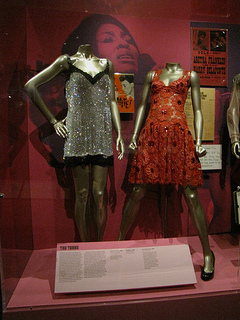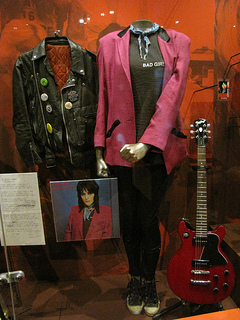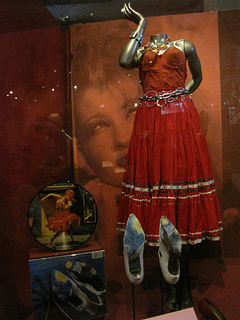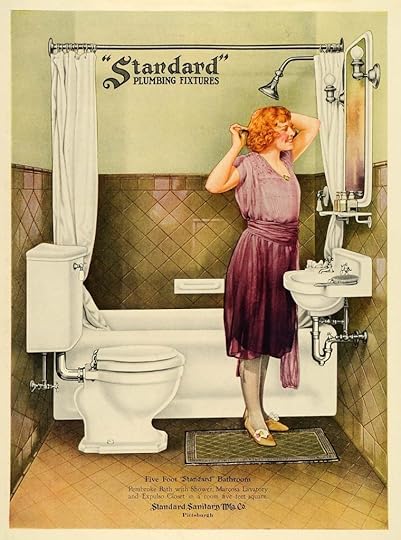Wendi Dunlap's Blog, page 4
June 14, 2013
“Women Who Rock” and wear sparkly things
Tina Turner, represented by two dresses. All photos on this page by Wendi Dunlap.
The new “Women Who Rock” exhibit opens today at the EMP Museum. I saw a preview this week, and though I enjoyed it, as I left the exhibit I had definite mixed feelings about it.The exhibit opens with a great photo of Joan Jett with a “takes no shit from anyone” look and a guitar slung over her shoulder. The next thing you see is a timeline, then a piano — Lady Gaga’s childhood piano, as it turns out. Appropriately, the exhibit starts with the music, or at least, one of the tools to create it.
Around the corner you go, seeing memorabilia of some of the earlier influences including Bessie Smith, Sister Rosetta Tharpe and LaVern Baker. It’s good that the exhibit reaches into pre-rock history, though I wanted more of it, history geek that I am.
Turning to your right, you see an impressive US-flag-style dress on a headless mannequin in a glass case, next to another mannequin frilly black and yellow dress sprinkled with tiny musical notes. The flag dress was made for Wanda Jackson by her mom; the yellow one was worn by Ruth Brown. There are some other memorabilia pieces in the display — Jackson’s guitar, Brown’s record — but what draws your eye here is the costuming. And this focus continues through the rest of the exhibit.
Joan Jett has a “Bad Reputation” and also NO HEAD.
We see sparkly dresses worn by members of the Supremes, really short sparkly dresses worn by Tina Turner, and flowing dresses worn by Stevie Nicks, Mama Cass, and the Wilson sisters from Heart. Loretta Lynn’s dress is essentially a 1980s wedding dress in pink: sparkly beaded bodice, big puffy shoulders, and a chiffon skirt. And a nice guitar next to it, but the “ooh, shiny” steals its thunder.Some costumes are less girly: Joan Jett, of course, with a leather jacket (sporting a Keep Abortion Legal badge), and the outfit she wore on the I Love Rock & Roll album cover. Kim Gordon of Sonic Youth is represented with a shirt bearing the phrase “Eat Me” and the Rolling Stones’ tongue logo.
The definition of “rock” is pretty broad by the time you get to the Britney Spears and Shakira outfits, basically sequined pants with bikini tops. Both mannequins have belly buttons. I think Shakira’s gets a six-pack; no such luck for Britney.
There is a case nearby with a mannequin wearing something that looked like something out of a horror film, red and gross. Yes, it’s Lady Gaga’s meat dress — “meat jerky by now,” we were told. At this point I heard one of the other reviewers mumbling thoughts similar to mine: “Why is it all clothes?” To be fair, it’s not all clothes. Quite a few of the mannequins come with guitars, and some have album covers or magazine articles on display showing the clothing being worn. A few have handwritten lyrics or letters. There is a wealth of text to read about each performer. But the fundamental format of the exhibit is basically mannequins wearing cool stage costumes.
Cyndi Lauper: “She’s So Unusual” because it is definitely unusual to have no head!
The focus on the costumes seems to be both a positive and a negative. On the negative side, the heavy emphasis on costumes seems to crowd out memorabilia that I have seen in other exhibits — more letters, press, vintage posters, tickets, etc. It tends to define almost all the artists by their clothing, displayed on those (mostly) headless, nearly interchangeable mannequins. (The only ones with heads were ones with hats. And those heads were generic.) What’s important, it says, is what’s below the neck. This is what defines each artist. And this is problematic.Women in rock are not about their clothes — the clothes are a sideline and kind of a distraction. Show me more video, show me more memorabilia — how about the kind of display where it feels as if “you are there” seeing some of them perform, instead of dead faceless mannequins wearing pretty clothing? What was it like to see Ruth Brown sing “(Mama) He Treats Your Daughter Mean” at the Mambo Club in Wichita, Kansas in 1956? What was it like to see Blondie at CBGB’s in 1977? The display is more “Nordstrom window” than “rock and roll.”
On the positive side, seeing so many mannequins does give you a bit of a feeling that “hey, there are a lot of women in rock, and this is only touching the surface.” And at the same time, it gives you that sense that they are just people like yourself — maybe shorter than you are, maybe thinner, maybe not — not some onstage demigods glowing under a spotlight.
I must admit that I personally find costume interesting. I’ve researched it, and it’s one of the aspects of history that draws my attention, so I enjoyed seeing the clothing, but I did not like that it really seemed to be the focus. Having costumes there is good, but the exhibit seems kind of imbalanced.
That does not mean you shouldn’t go see it anyway, though. Imbalanced or not, the exhibit is still fascinating. I just wish it could have been more.
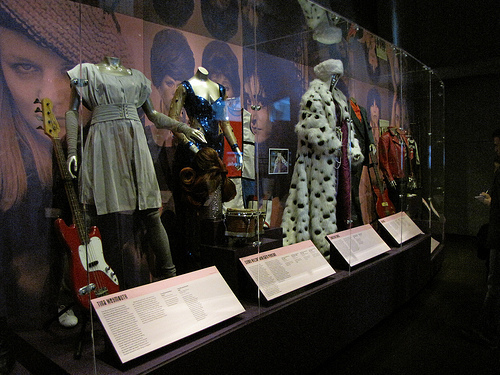
Is this the Nordstrom half-yearly sale? How much for the dress in gray?
May 5, 2013
Pinterest pinner of the moment: Craftsman Junky
Craftsman Junky’s collection of pinboards — this is only a partial section of the list. Click through to see the full page.
Instead of choosing one Pinterest board to write about this week, I’ve chosen a collection of pinboards by a single pinner: Craftsman Junky. Craftsman Junky is actually Sharon from the Laurelhurst 1912 Craftsman blog about renovating a 1912 Craftsman home in Portland, Oregon. Since I have a 1911 Craftsman bungalow in Seattle, this is relevant to my interests.The blog is great itself, but the collection of images and links that Sharon has compiled on Pinterest is really stunning. Check out this list of boards:
House Interiors (early 1900s)
House Exteriors (early 1900s)
Craftsman Dining Rooms
Craftsman Living Rooms
Craftsman Bedrooms
Craftsman Remodel
Early 1900s Bathrooms
Remodeled Bathrooms
Early 1900s Kitchens
Remodeled Kitchens
Shopping Resources
Craftsman Furniture
Craftsman Stencils, Wallpaper and Paint Colors
Early 1900s Tile
There are more, including collections of early 20th Century clothing. If you have an old house, or any interest in Arts and Crafts style of the early 1900s, these are great boards to follow.
April 25, 2013
“In a room five feet square.”
While working on remodeling my bungalow bathroom (more on that later) I was looking for some vintage art to put on the wall. I found this 1922 ad:
I loved it immediately and decided that would be on my wall. (I ordered it from this eBay seller.) But, note the caption:
“Five Foot ‘Standard’ Bathroom
Pembroke Bath with Shower, Marcosa Lavatory
and Expulso Closet in a room five feet square.”
Five feet square?! 25 square feet? That’s a pretty small room, but it is possible if the sink is small. I grew up in a house that had a very small bathroom, but it was closer to 5′x7′ — the sink and toilet could both fit on the same wall, which at least left room for a laundry hamper.
Looking at other Standard ads from the 1920s, I saw this theme repeated over and over, usually with gorgeous painted artwork to illustrate (click each image to see a full version):
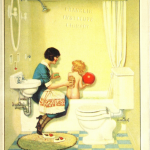
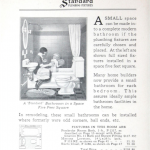
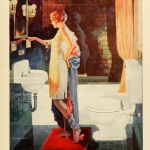
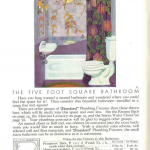
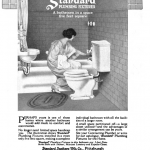
The advertising emphasized the flexibility and freedom of having these small bathrooms as convenient extra bathrooms in one’s home to “assure ideally ample bathroom facilities” and allow “leisurely washing, and splashing, and fixing, and primping before the lavatory glass.”
This ad attempted to appeal to both women and the men in their homes who might be irritated at the time spent in the bath:
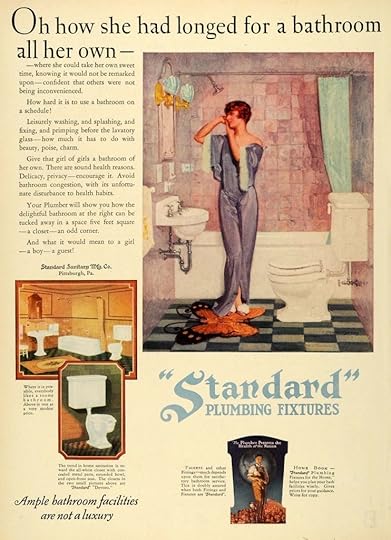
“Oh how she had longed for a bathroom all her own” — the freedom of not sharing a bathroom, by installing one in a five foot square space.
“Ample bathroom facilities are not a luxury.” Though the room is small, it has rose tiles and a checked linoleum floor, with elaborate light fixtures.
Oh how she had longed for a bathroom all her own — where she could take her own sweet time, knowing it would not be remarked upon — confident that others were not being inconvenienced.
How hard it is to use a bathroom on schedule!
The bathroom in this ad, though tiny, had a sense of feminine luxury, with rose-colored tilework, golden sconces with aqua shades, and a butterfly area rug.
Unspoken in the Five Foot Square ad campaign was something else — if you can install a full bathroom in such a small space, you can easily add bathrooms to homes that previously didn’t have indoor plumbing.
Standard ads, both in the 1920s and otherwise, tended to promote elaborate and expensive luxury bathroom designs, ones which were out of reach for many. Earlier ads often showed fairly large bathrooms with features such as bidets and sitz baths, and it was common for the ads to show household maids at work in the bathroom. Here are a couple of the earlier Standard ads:
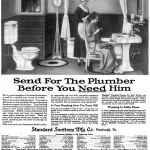
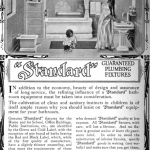
The Five Feet Square ads combined an appeal to luxury (extra baths for the lady who has everything) with an appeal to those homeowners still in smaller, older houses: you too, they said, can have glamorous indoor plumbing. All you need is a spare closet or the end of a hallway!
Whether the campaign was successful or not, I don’t know. By the 1930s, Standard seems to have moved on to ads emphasizing color, Art Deco modernity, and the replacement of old, “unsightly” fixtures such as clawfoot tubs. If you want a bathroom in a room five feet square, though, American Standard (formerly Standard) still sells a tiny sink or two.

